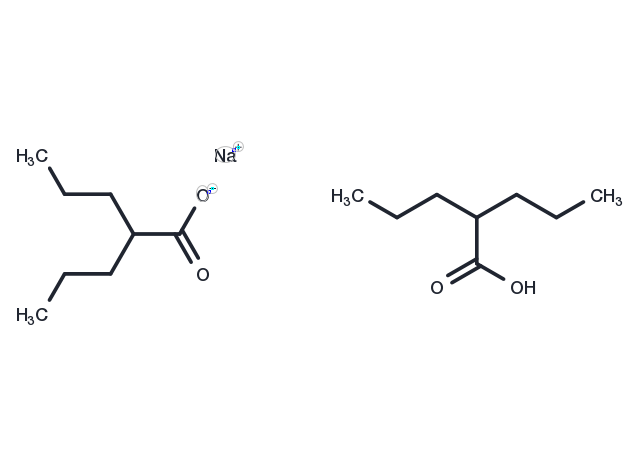Powder: -20°C for 3 years | In solvent: -80°C for 1 year


Divalproex Sodium (Valproate semisodium) binds to and inhibits gamma-aminobutyric acid (GABA) transaminase and its anticonvulsant activity may be exerted by increasing brain concentration of GABA and by inhibiting enzymes that catabolize GABA or block the reuptake of GABA into glia and nerve endings. It also is an HDAC inhibitor, Comprised of sodium valproate and valproic acid with anticonvulsant and antiepileptic activities. Divalproex may also work by suppressing repetitive neuronal firing through the inhibition of voltage-sensitive sodium channels.

| Pack Size | Availability | Price/USD | Quantity |
|---|---|---|---|
| 10 mg | In stock | $ 33.00 | |
| 25 mg | In stock | $ 50.00 | |
| 50 mg | In stock | $ 72.00 | |
| 100 mg | In stock | $ 118.00 | |
| 200 mg | In stock | $ 198.00 | |
| 500 mg | In stock | $ 353.00 | |
| 1 mL * 10 mM (in DMSO) | In stock | $ 50.00 |


| Description | Divalproex Sodium (Valproate semisodium) binds to and inhibits gamma-aminobutyric acid (GABA) transaminase and its anticonvulsant activity may be exerted by increasing brain concentration of GABA and by inhibiting enzymes that catabolize GABA or block the reuptake of GABA into glia and nerve endings. It also is an HDAC inhibitor, Comprised of sodium valproate and valproic acid with anticonvulsant and antiepileptic activities. Divalproex may also work by suppressing repetitive neuronal firing through the inhibition of voltage-sensitive sodium channels. |
| In vitro | Divalproex sodium enhances apoptosis, IM-induced cell growth inhibition and cell cycle arrest in K562-G and K562-S cells. It enhances the inhibitory effects of IM on SIRT1 expression in K562-G and K562-S cells. Divalproex sodium enhances the effect of IM on apoptosis in K562-G cells partly through SIRT1. |
| In vivo | Divalproex (500 mg/kg) significantly increases dopamine (DA) and acetylcholine (ACh) efflux in the rat hippocampus, and DA, but not ACh, efflux in the rat medial prefrontal cortex (mPFC), whereas 50 mg/kg has no effect on DA or ACh in either region. Divalproex (50 mg/kg) combined with the atypical APDs Olanzapine (1.0 mg/kg) or Aripiprazole (0.3 mg/kg) significantly potentiates the effect of both antipsychotic drugs (APDs) on DA, but not ACh efflux in the HIP and mPFC. |
| Synonyms | Valproate semisodium, Epival |
| Molecular Weight | 310.41 |
| Formula | C8H16O2·C8H15O2·Na |
| CAS No. | 76584-70-8 |
Powder: -20°C for 3 years | In solvent: -80°C for 1 year
H2O: 57 mg/mL (183.6 mM)
DMSO: 58 mg/mL (186.8 mM)
Ethanol: 58 mg/mL (186.8 mM)
You can also refer to dose conversion for different animals. More
bottom
Please see Inhibitor Handling Instructions for more frequently ask questions. Topics include: how to prepare stock solutions, how to store products, and cautions on cell-based assays & animal experiments, etc.
Divalproex Sodium 76584-70-8 Chromatin/Epigenetic DNA Damage/DNA Repair HDAC Mitophagy Notch Apoptosis Histone deacetylases Autophagy hepatic fat accumulation Notch1 headaches Mitochondrial Autophagy small cell lung cancer degradation Valproate semisodium epilepsy HIV Endogenous Metabolite Valproic acid (sodium)(2:1) bipolar disorder VPA (sodium)(2:1) anticonvulsant Epival 2-Propylpentanoic Acid (sodium)(2:1) SCLC proteasomal anticancer inhibit migraine Inhibitor Human immunodeficiency virus inhibitor
